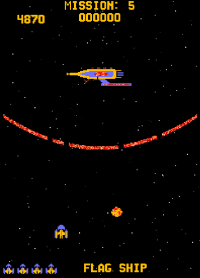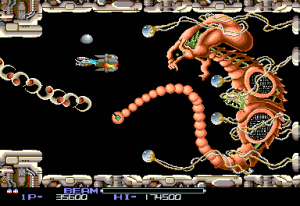Boss (video games)
|
|

In video games, a boss (sometimes called a guardian) is a particularly large or difficult computer-controlled character that must be defeated at the end of a segment of a game, whether it be for a level, an episode, or the very end of the game itself. Bosses appear in many video games, particularly story or level-based first and third-person shooters, platform games, CRPGs, and most shoot 'em ups.
| Contents |
Bosses in game structure
Many single-player games feature a level/episode structure, the game becoming progressively harder as the player advances. Bosses are a consequence of this structure, appearing at the end of a level or episode and being the hardest enemies to defeat. Other games have a storyline instead of a level-based structure, but they still feature boss-like enemies at various points in the story or at the end of the storyline.
The boss battle generally marks the climax of a dramatic buildup resulting from the player's anticipation and anxiousness. Game designers often add design elements, such as suspenseful music, that enhance this effect. For example, in Metal Gear Solid, the penultimate battle has been heavily foreshadowed in dialogue, and the threat represented by the boss enhanced by an attempt to disable or destroy it before it is mobile.
A weaker version of a boss that appears earlier in the level is called a miniboss (alternately known as a sub-boss). These are generally intermediate between bosses and standard enemies in their properties. The Hammer Brothers in the Super Mario Bros. game are generally considered minibosses.
Occasionally, a defeated miniboss or boss may return as a standard enemy at a later stage of the game. This typically only applies to bosses or minibosses which are not characters in the game's storyline. For example, in Metroid Prime, the player encounters many Baby Sheegoths before a boss battle against a fully grown one; upon revisiting the level at a later stage, adult Sheegoths are commonplace. In Blood, Cheogh and Shial appear as regular enemies after you kill them. In Duke Nukem 3D, after you defeat the Battlelord, weaker versions of him appear in later levels.
Bosses are traditional choke-points in RPGs, used to ensure a player has taken the time to level-up (raise their abilities through fighting anonymous foes) before progressing to a new section of the game. A player may find that they have not increased in level sufficiently to weather a boss's attacks, and must spend time gaining experience points by fighting lowlier creatures (often a very repetitive process) before attempting the battle again. This can be viewed as an effort to ensure the player has the level the designer expects before they progress, however it is one of the more common frustrations with the genre.
Characteristics
In complex games (particularly role-playing games), bosses are so noted for effective attacks and a large number of hit points. They also have "special" attacks, such as stunning/freezing the player, teleportation, inflicting curses on the characters that decrease their abilities, and so forth. Bosses are often immune to certain abilities that the player possesses, and often can only be defeated by specific attacks and strategies, or by using the environment or their own attacks against them. A common way of implying this power is to make the boss much larger than the player's on-screen representation, as opposed to normal enemies, who are more commonly smaller than the player, or at most roughly equal in size.
TMNT_Turtles_in_Time_screenshot.png
In versus fighting games such as Street Fighter II, the final few characters the player faces in matches are usually referred to as bosses, as they are placed at the end of the game and have noticeably greater difficulty than previous opponents. Bosses in these games are often not available as playable characters at leisure.
In scrolling fighting games and other arcade games, a boss's health level is often determined by a health bar comparatively longer than the player's. When not determined in this manner, however, the character flashes red as he takes hits, progressively flashing faster until he is defeated. This not only determines the boss's health, but also permits internal programming to discreetly adjust it as players enter and leave the game during the boss battle. Sometimes, bosses may also adjust their attacks according to how much damage they are taking.
In more fantasy- or science-fiction oriented First Person Shooter games like Doom or Quake where the player faces different species of monsters, bosses are generally large, highly durable monsters, often with their own unique weapons or special pre-scripted attacks and arenas. In more realistic FPS games where the player faces exclusively human foes, bosses often are unique characters who behave exactly like regular enemies, only with better weapons and more health.
In most adventure games, there is no real-time combat and thus no boss fights per-se, although the final puzzle often involves defeating the game's main villain, generally utilizing the environment or some previously unused object in your inventory, sometimes under a time limit in which you must act quickly or be killed.
There is a very rare breed of boss sometimes called the "trick boss". This is a boss who is extremely powerful and can't be easily defeated by the characters at their current level. In many cases there is a particular weapon, skill, or special item that can be obtained to defeat the boss easily. Otherwise the player is left to continue to gain experience until they can beat the boss the normal way. The most famous example of this is the Garuda in Final Fantasy III which can be beaten relatively easily by turning all of your party members into Lancers. Other famous examples are the demon dog from 7th Saga, who isn't that tough, but can be defeated by a whistle you get from his former master. Also The Emperor from Final Fantasy II who is a final boss. He can be defeated easily by using the deceptively powerful Blood Swords. Keeleon from Dragon Quest IV is another good example, and can only be beaten easily with the Sword of Lethargy. It's important to note that these bosses can be defeated by normal means, unlike Lasheic from Phantasy Star or Zeromus from Final Fantasy IV who require special items to defeat.
History
The first boss in the history of video games was the Golden Dragon, created by Gary Whisenhunt and Ray Wood in 1974 for dnd, a game styled around Dungeons and Dragons for the PLATO system. Until this point, games had an infinitely repeating nature (Pong or Asteroids); the boss represented an attempt to legitimize the video game as a type of story, with a difficult opponent ending the game as a denouement or climax.
Criticisms
Bosses have recently become to fall out of favour with groups of videogamers and specific game designers; it is commonly argued that they are a hangover from pay-to-play arcade games, and inappropriate for current games. Poorly engineered bosses may simply be an enemy which absorbs an exasperating amount of damage without providing especially engaging gameplay, existing purely to slow the player's progress. Particularly boss-heavy games may lack coherent segments between the bosses; this is frequently an issue in 2D shooters such as Contra: Hard Corps.
Some gamers have complained that bosses can break the suspension of disbelief by disrupting the level of realism. In games which attempt for a "realistic" atmosphere where the player character and the enemies can survive about as much damage as a "real" human being (albeit perhaps one wearing body armor) could, it can be quite jarring to suddenly encounter an enemy who can survive superhuman amounts of damage. For example, the incongruously drawn-out boss battles at the finales of Half-Life and Halo 2 were derided by many as repetitive, awkward endings to otherwise dramatic, coherent games.
Alternatively, some view bosses as the ultimate expression of the concepts in the game's design, the other segments bridging and introducing ideas to be explored fully in the boss battles. Developer Treasure constructed Alien Soldier as a relentless series of bosses to interesting effect; the Metal Gear series includes its bosses as the ongoing storyline, battles with them driving the plot ahead; in the Metroid saga, bosses test the player's skill and grant them new abilities which allow the gameplay to expand.
Some notable games which do not include bosses are Half-Life 2, the original Halo, and Thief II: The Metal Age.
Superbosses
A superboss in a videogame is an optional major enemy of extreme difficulty. A superboss is usually found near the end of a game, generally, but not always, stronger than the final antagonist. They exist to give the player an extra challenge and offer great rewards for their defeat, although it is mostly for bragging rights. The Final Fantasy series traditionally does not offer any form of reward that is of any use to the player in the game.
Examples of superbosses include:
- Warmech in Final Fantasy I
- Omega in Final Fantasy V
- Emerald WEAPON, Ruby WEAPON and Ultimate WEAPON in Final Fantasy VII
- Ultima Weapon and Omega Weapon in Final Fantasy VIII
- Ozma in Final Fantasy IX
- Nemesis in Final Fantasy X
- Deadbeard in Golden Sun
- Dullahan, Star Magician, Valukar, and Sentinel in Golden Sun: The Lost Age
- Sephiroth in Kingdom Hearts
- Culex in Super Mario RPG
- Bonetail in Paper Mario: The Thousand-Year Door
- Abyssion in Tales of Symphonia
List of famous or noteworthy bosses

- Abobo (Double Dragon)
- Andross (Star Fox)
- The Barons of Hell (The Doom series)
- Big Boss (Metal Gear series)
- Bowser Koopa (Mario series)
- Chaos (Final Fantasy character) (Final Fantasy)
- Carla the Sword Master (The Secret of Monkey Island)
- The Cyberdemon (The Doom series)
- Darth Malak (Star Wars: Knights of the Old Republic)
- Dobkeratops (or Doppelganger, or Gladiator or Krell) (R-Type)
- Doctor Eggman/Doctor Robotnik (Sonic the Hedgehog series)
- Dizzy (Guilty Gear series)
- Dracula (Castlevania series)
- Ex-Death (Final Fantasy V)
- Flag Ship (Gorf)
- Frank Horrigan (Fallout II)
- Ganon (Legend of Zelda series)
- Golden Dragon (dnd)
- Goro (Mortal Kombat)
- Great Thing (Darius series)
- Hustler One (Armored Core series)
- John Romero's head a.k.a. Icon of Sin (DOOM II)
- K. Rool (Donkey Kong Country series, Donkey Kong 64)
- Kefka Palazzo (Final Fantasy VI)
- Lavos (Chrono Trigger)
- LeChuck (The Secret of Monkey Island)
- The Makron (Quake II)
- The Master (Fallout)
- M. Bison (Street Fighter II)
- Metal Sonic (Sonic the Hedgehog series)
- Master-D (Bionic Commando)
- Mortimer McMire (Commander Keen series)
- Mother Brain (Metroid series)
- The Mothership (Gradius)
- Dr. Neo Cortex (Crash Bandicoot series)
- Nihilanth (Half-Life)
- Nine-Ball (Armored Core)
- Orstedd (Live a Live)
- Psycho Mantis (Metal Gear Solid)
- Purple Tentacle (Day of the Tentacle)
- Ridley and its various incarnations in the Metroid series.
- Ripto (Spyro 2: Ripto's Rage)
- Rugal Bernstein (King of Fighters series)
- Schwarzgeist (Einhander)
- Morganna Mode Gone (.hack)
- Sephiroth (Final Fantasy VII)
- Shub-Niggurath (Quake)
- Sigma (Mega Man X series)
- Sinistar (Sinistar)
- Tartarus (Halo 2)
- Ugh Zan III (at the end of the First Enounter in Serious Sam series)
- Ultimecia (Final Fantasy VIII)
- Wild Dog (Time Crisis series)
- Dr. Wily (Mega Man series)
- The Wizard of Yendor (NetHack)
- Mr. X (Bare Knuckle series)
External links
- The Ten Best Boss Fight Games (http://www.gamespot.com/gamespot/features/all/tenspot/0918boss/) – according to GameSpot.comde:Endgegner
